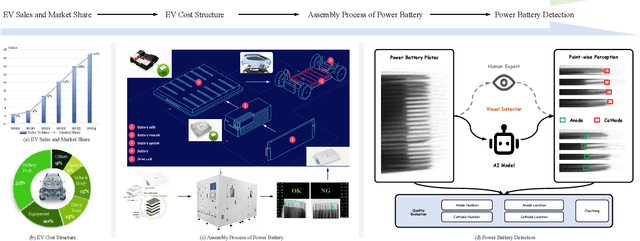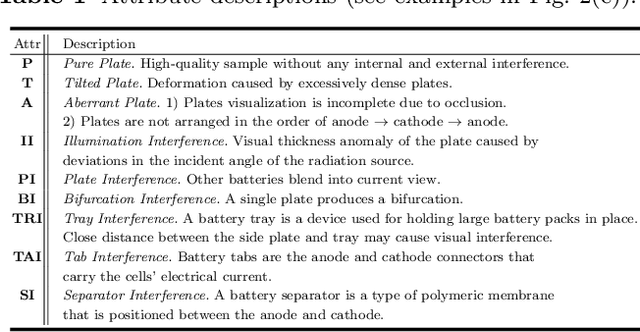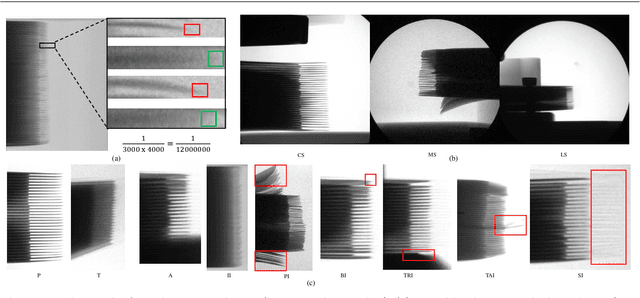Line Segment Detection
Line segment detection is the process of identifying straight lines in an image or video.
Papers and Code
Multi-View Camera System for Variant-Aware Autonomous Vehicle Inspection and Defect Detection
Sep 30, 2025Ensuring that every vehicle leaving a modern production line is built to the correct \emph{variant} specification and is free from visible defects is an increasingly complex challenge. We present the \textbf{Automated Vehicle Inspection (AVI)} platform, an end-to-end, \emph{multi-view} perception system that couples deep-learning detectors with a semantic rule engine to deliver \emph{variant-aware} quality control in real time. Eleven synchronized cameras capture a full 360{\deg} sweep of each vehicle; task-specific views are then routed to specialised modules: YOLOv8 for part detection, EfficientNet for ICE/EV classification, Gemini-1.5 Flash for mascot OCR, and YOLOv8-Seg for scratch-and-dent segmentation. A view-aware fusion layer standardises evidence, while a VIN-conditioned rule engine compares detected features against the expected manifest, producing an interpretable pass/fail report in \(\approx\! 300\,\text{ms}\). On a mixed data set of Original Equipment Manufacturer(OEM) vehicle data sets of four distinct models plus public scratch/dent images, AVI achieves \textbf{ 93 \%} verification accuracy, \textbf{86 \%} defect-detection recall, and sustains \(\mathbf{3.3}\) vehicles/min, surpassing single-view or no segmentation baselines by large margins. To our knowledge, this is the first publicly reported system that unifies multi-camera feature validation with defect detection in a deployable automotive setting in industry.
POEv2: a flexible and robust framework for generic line segment detection and wireframe line segment detection
Aug 27, 2025Line segment detection in images has been studied for several decades. Existing line segment detectors can be roughly divided into two categories: generic line segment detectors and wireframe line segment detectors. Generic line segment detectors aim to detect all meaningful line segments in images and traditional approaches usually fall into this category. Recent deep learning based approaches are mostly wireframe line segment detectors. They detect only line segments that are geometrically meaningful and have large spatial support. Due to the difference in the aim of design, the performance of generic line segment detectors for the task of wireframe line segment detection won't be satisfactory, and vice versa. In this work, we propose a robust framework that can be used for both generic line segment detection and wireframe line segment detection. The proposed method is an improved version of the Pixel Orientation Estimation (POE) method. It is thus named as POEv2. POEv2 detects line segments from edge strength maps, and can be combined with any edge detector. We show in our experiments that by combining the proposed POEv2 with an efficient edge detector, it achieves state-of-the-art performance on three publicly available datasets.
TriLiteNet: Lightweight Model for Multi-Task Visual Perception
Sep 04, 2025Efficient perception models are essential for Advanced Driver Assistance Systems (ADAS), as these applications require rapid processing and response to ensure safety and effectiveness in real-world environments. To address the real-time execution needs of such perception models, this study introduces the TriLiteNet model. This model can simultaneously manage multiple tasks related to panoramic driving perception. TriLiteNet is designed to optimize performance while maintaining low computational costs. Experimental results on the BDD100k dataset demonstrate that the model achieves competitive performance across three key tasks: vehicle detection, drivable area segmentation, and lane line segmentation. Specifically, the TriLiteNet_{base} demonstrated a recall of 85.6% for vehicle detection, a mean Intersection over Union (mIoU) of 92.4% for drivable area segmentation, and an Acc of 82.3% for lane line segmentation with only 2.35M parameters and a computational cost of 7.72 GFLOPs. Our proposed model includes a tiny configuration with just 0.14M parameters, which provides a multi-task solution with minimal computational demand. Evaluated for latency and power consumption on embedded devices, TriLiteNet in both configurations shows low latency and reasonable power during inference. By balancing performance, computational efficiency, and scalability, TriLiteNet offers a practical and deployable solution for real-world autonomous driving applications. Code is available at https://github.com/chequanghuy/TriLiteNet.
From Lines to Shapes: Geometric-Constrained Segmentation of X-Ray Collimators via Hough Transform
Sep 04, 2025Collimation in X-ray imaging restricts exposure to the region-of-interest (ROI) and minimizes the radiation dose applied to the patient. The detection of collimator shadows is an essential image-based preprocessing step in digital radiography posing a challenge when edges get obscured by scattered X-ray radiation. Regardless, the prior knowledge that collimation forms polygonal-shaped shadows is evident. For this reason, we introduce a deep learning-based segmentation that is inherently constrained to its geometry. We achieve this by incorporating a differentiable Hough transform-based network to detect the collimation borders and enhance its capability to extract the information about the ROI center. During inference, we combine the information of both tasks to enable the generation of refined, line-constrained segmentation masks. We demonstrate robust reconstruction of collimated regions achieving median Hausdorff distances of 4.3-5.0mm on diverse test sets of real Xray images. While this application involves at most four shadow borders, our method is not fundamentally limited by a specific number of edges.
Why Stop at Words? Unveiling the Bigger Picture through Line-Level OCR
Aug 29, 2025Conventional optical character recognition (OCR) techniques segmented each character and then recognized. This made them prone to error in character segmentation, and devoid of context to exploit language models. Advances in sequence to sequence translation in last decade led to modern techniques first detecting words and then inputting one word at a time to a model to directly output full words as sequence of characters. This allowed better utilization of language models and bypass error-prone character segmentation step. We observe that the above transition in style has moved the bottleneck in accuracy to word segmentation. Hence, in this paper, we propose a natural and logical progression from word level OCR to line-level OCR. The proposal allows to bypass errors in word detection, and provides larger sentence context for better utilization of language models. We show that the proposed technique not only improves the accuracy but also efficiency of OCR. Despite our thorough literature survey, we did not find any public dataset to train and benchmark such shift from word to line-level OCR. Hence, we also contribute a meticulously curated dataset of 251 English page images with line-level annotations. Our experimentation revealed a notable end-to-end accuracy improvement of 5.4%, underscoring the potential benefits of transitioning towards line-level OCR, especially for document images. We also report a 4 times improvement in efficiency compared to word-based pipelines. With continuous improvements in large language models, our methodology also holds potential to exploit such advances. Project Website: https://nishitanand.github.io/line-level-ocr-website
Few-Shot Connectivity-Aware Text Line Segmentation in Historical Documents
Aug 26, 2025A foundational task for the digital analysis of documents is text line segmentation. However, automating this process with deep learning models is challenging because it requires large, annotated datasets that are often unavailable for historical documents. Additionally, the annotation process is a labor- and cost-intensive task that requires expert knowledge, which makes few-shot learning a promising direction for reducing data requirements. In this work, we demonstrate that small and simple architectures, coupled with a topology-aware loss function, are more accurate and data-efficient than more complex alternatives. We pair a lightweight UNet++ with a connectivity-aware loss, initially developed for neuron morphology, which explicitly penalizes structural errors like line fragmentation and unintended line merges. To increase our limited data, we train on small patches extracted from a mere three annotated pages per manuscript. Our methodology significantly improves upon the current state-of-the-art on the U-DIADS-TL dataset, with a 200% increase in Recognition Accuracy and a 75% increase in Line Intersection over Union. Our method also achieves an F-Measure score on par with or even exceeding that of the competition winner of the DIVA-HisDB baseline detection task, all while requiring only three annotated pages, exemplifying the efficacy of our approach. Our implementation is publicly available at: https://github.com/RafaelSterzinger/acpr_few_shot_hist.
Power Battery Detection
Aug 11, 2025



Power batteries are essential components in electric vehicles, where internal structural defects can pose serious safety risks. We conduct a comprehensive study on a new task, power battery detection (PBD), which aims to localize the dense endpoints of cathode and anode plates from industrial X-ray images for quality inspection. Manual inspection is inefficient and error-prone, while traditional vision algorithms struggle with densely packed plates, low contrast, scale variation, and imaging artifacts. To address this issue and drive more attention into this meaningful task, we present PBD5K, the first large-scale benchmark for this task, consisting of 5,000 X-ray images from nine battery types with fine-grained annotations and eight types of real-world visual interference. To support scalable and consistent labeling, we develop an intelligent annotation pipeline that combines image filtering, model-assisted pre-labeling, cross-verification, and layered quality evaluation. We formulate PBD as a point-level segmentation problem and propose MDCNeXt, a model designed to extract and integrate multi-dimensional structure clues including point, line, and count information from the plate itself. To improve discrimination between plates and suppress visual interference, MDCNeXt incorporates two state space modules. The first is a prompt-filtered module that learns contrastive relationships guided by task-specific prompts. The second is a density-aware reordering module that refines segmentation in regions with high plate density. In addition, we propose a distance-adaptive mask generation strategy to provide robust supervision under varying spatial distributions of anode and cathode positions. The source code and datasets will be publicly available at \href{https://github.com/Xiaoqi-Zhao-DLUT/X-ray-PBD}{PBD5K}.
Radar-Based NLoS Pedestrian Localization for Darting-Out Scenarios Near Parked Vehicles with Camera-Assisted Point Cloud Interpretation
Aug 06, 2025The presence of Non-Line-of-Sight (NLoS) blind spots resulting from roadside parking in urban environments poses a significant challenge to road safety, particularly due to the sudden emergence of pedestrians. mmWave technology leverages diffraction and reflection to observe NLoS regions, and recent studies have demonstrated its potential for detecting obscured objects. However, existing approaches predominantly rely on predefined spatial information or assume simple wall reflections, thereby limiting their generalizability and practical applicability. A particular challenge arises in scenarios where pedestrians suddenly appear from between parked vehicles, as these parked vehicles act as temporary spatial obstructions. Furthermore, since parked vehicles are dynamic and may relocate over time, spatial information obtained from satellite maps or other predefined sources may not accurately reflect real-time road conditions, leading to erroneous sensor interpretations. To address this limitation, we propose an NLoS pedestrian localization framework that integrates monocular camera image with 2D radar point cloud (PCD) data. The proposed method initially detects parked vehicles through image segmentation, estimates depth to infer approximate spatial characteristics, and subsequently refines this information using 2D radar PCD to achieve precise spatial inference. Experimental evaluations conducted in real-world urban road environments demonstrate that the proposed approach enhances early pedestrian detection and contributes to improved road safety. Supplementary materials are available at https://hiyeun.github.io/NLoS/.
ScaleLSD: Scalable Deep Line Segment Detection Streamlined
Jun 11, 2025This paper studies the problem of Line Segment Detection (LSD) for the characterization of line geometry in images, with the aim of learning a domain-agnostic robust LSD model that works well for any natural images. With the focus of scalable self-supervised learning of LSD, we revisit and streamline the fundamental designs of (deep and non-deep) LSD approaches to have a high-performing and efficient LSD learner, dubbed as ScaleLSD, for the curation of line geometry at scale from over 10M unlabeled real-world images. Our ScaleLSD works very well to detect much more number of line segments from any natural images even than the pioneered non-deep LSD approach, having a more complete and accurate geometric characterization of images using line segments. Experimentally, our proposed ScaleLSD is comprehensively testified under zero-shot protocols in detection performance, single-view 3D geometry estimation, two-view line segment matching, and multiview 3D line mapping, all with excellent performance obtained. Based on the thorough evaluation, our ScaleLSD is observed to be the first deep approach that outperforms the pioneered non-deep LSD in all aspects we have tested, significantly expanding and reinforcing the versatility of the line geometry of images. Code and Models are available at https://github.com/ant-research/scalelsd
Advanced Integration of Discrete Line Segments in Digitized P&ID for Continuous Instrument Connectivity
May 17, 2025Piping and Instrumentation Diagrams (P&IDs) constitute the foundational blueprint of a plant, depicting the interconnections among process equipment, instrumentation for process control, and the flow of fluids and control signals. In their existing setup, the manual mapping of information from P&ID sheets holds a significant challenge. This is a time-consuming process, taking around 3-6 months, and is susceptible to errors. It also depends on the expertise of the domain experts and often requires multiple rounds of review. The digitization of P&IDs entails merging detected line segments, which is essential for linking various detected instruments, thereby creating a comprehensive digitized P&ID. This paper focuses on explaining how line segments which are detected using a computer vision model are merged and eventually building the connection between equipment and merged lines. Hence presenting a digitized form of information stating the interconnection between process equipment, instrumentation, flow of fluids and control signals. Eventually, which can be stored in a knowledge graph and that information along with the help of advanced algorithms can be leveraged for tasks like finding optimal routes, detecting system cycles, computing transitive closures, and more.
 Add to Chrome
Add to Chrome Add to Firefox
Add to Firefox Add to Edge
Add to Edge